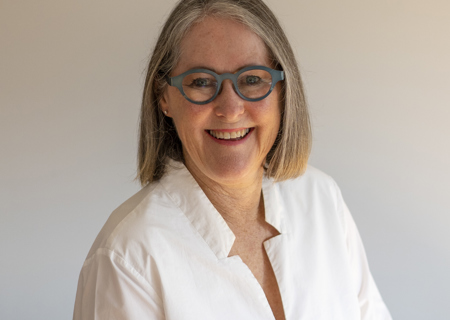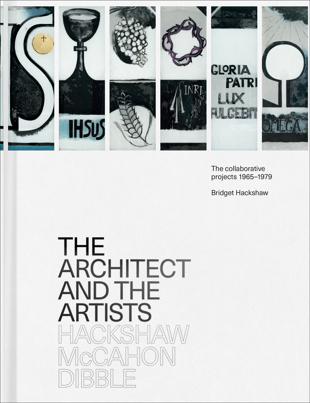Q1: When did the idea that you should write this book first seed in your mind?
I began reading, photographing and researching this subject at the beginning of 2018 with the aim to put photographs and a leaflet into the archives at the School of Architecture and Planning with Dad’s plans and drawings. Chris Dudman and I began making the film about the collaboration between my father, Colin McCahon and Paul Dibble that year, but it was in May 2020 that Auckland businessman and philanthropist Adrian Burr saw some film clips and said that a book also needed to be made. Adrian had generously supported us to make the film and book, but sadly he died before either was completed.
Q2: It must have felt a daunting project at the outset?
I wasn’t really daunted because I had no big end plan for the research and documentation. It turned out to be very exciting and incredibly interesting finding the buildings and artworks, piecing the story together and trying to understand what the three artists were attempting.
Q3: Given that both your father, James Hackshaw, and Colin McCahon had died, how critical were their archives to you?
The archives were invaluable. I was able to authenticate work, see exactly when it was made and get some insights into its genesis. Dad’s archives at the University of Auckland contain his drawings, plans, photographs and a few letters. The Hocken Collections Uare Taoka o Hākena, the Alexander Turnbull Library Collections Archives, the St Mary’s Church Archives and the O’Reilly Family Collection contain numerous letters that McCahon wrote to friends and clients describing the commissions and his ideas about faith and art, as well as extensive drawings for the windows.
Q4: What was it like for you stepping back into these special buildings of your father’s, on which he and McCahon and Paul Dibble had worked, all these years later?
The building where I felt Dad the most was in St Patrick’s Church in Te Puke. Before it was closed as an earthquake risk and was still being used, I was given the key to spend as long as I wished there, alone. The light moves through the McCahon clerestory windows and floods colour over the seating and the floors. I found the Dibble candlesticks and crucifix on a shelf in the sacristy at the back of the church. I remembered Dad wistfully telling me how much he liked the building and artworks in that place. He was proud that he, McCahon and Dibble had reflected the local Te Puke community and landscape in their work there.
Q5: Some are in beautiful condition but others have suffered. It must have felt like a crisis when you learned that the Otara Convent was about to be bulldozed.
It was a shame that the Otara Convent needed to be bulldozed, but the potential crisis was that there were only five McCahon windows remaining out of twelve, and four of the remaining ones were very unassuming, so I needed to be quite assertive to have them rescued.
Q6: Your acknowledgements pages express your thanks to so many people — this book has really taken a village! But could you name a couple of key people who helped you make a breakthrough at important moments?
An enormous number of people have contributed to this being a productive and hugely enjoyable process. Adrian Burr was critical in initiating the book. A key breakthrough was quite early on, when Peter Simpson gave me some quotes from Colin McCahon’s letters to his friends about the windows. I then knew to search McCahon’s letters at the Hocken Collections and the Alexander Turnbull Library Collections and was able to copy thousands of pages of letters that were an invaluable resource.
Much of the groundwork for the book was carried out during the time that director Christopher Dudman and I we were filming. It was great to have someone else deeply engaged with the project to talk with, and his astute questioning of subjects was very helpful. It was reassuring to see someone else excited by the collaboration and works. The book would not be what it is without the contributions of Peter Shaw, Julia Gatley, Peter Simpson, Christopher Dudman, Alexa Johnston and Sister Maria Park. And of course Massey University Press agreeing to publish the book was a major breakthrough!
Q7: It must have felt great to hear Paul Dibble speak of working with your father and Colin McCahon?
It was wonderful to hear Paul Dibble as well as Peter Wood, who built so many of his buildings, and Morton Jordan and Wayne Lees, who worked with him in his practice at different times, talk about working with Dad when we filmed them. I realised that Dad’s practice had an impact on their practice.
Q8: Do you have a favourite among these buildings of your father’s?
I don’t have a favourite, I like them all for different reasons. I would especially love to find photographs of the interior of the Otara Convent. It was a very small and intimate, rimu-lined, square chapel for 15 sisters. It had a dozen McCahon windows, Dad’s native timber furniture, a Dibble tabernacle and a crucifix made by Garth Tapper and Colin McCahon. Only the tabernacle and some of the windows survive. McCahon wrote about this work in great detail, but I have no memory of Dad talking about it. It sounds like it was a gem.
Q9: And a favourite McCahon window and Dibble bronze from them?
I love all of McCahon’s windows. Their colour and often their scale add a very powerful and evocative dimension to the buildings. McCahon said ‘good glass holds your hands up high and a certain glory filters through your fingers’. He worked hard to make the work suit the particular places and people and was able to express his own ideas about faith. He called this work ‘working towards meaning’. Of Paul’s work, I especially like his tabernacles. They are solid, earthy and quite ornate and sometimes reflect local landmarks and iconography. They contrast beautifully with McCahon’s crisp coloured windows and the plain, solid native timber furniture and plinths that Dad designed.
Q10: Proud of the book?
I am thrilled that the goodwill and generosity of all the people who have contributed to this book has been rewarded with a public and permanent record of this body of work — and in many cases, includes their buildings.


